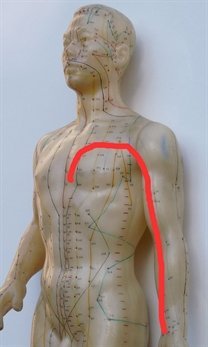
Heart and Kidney Yang deficiency
With Heart and Kidney Yang deficiency, you’ve overstressed your body’s ability to recover from over-exertion and cold.
The Pericardium Luo-connecting channel is an acupuncture channel. The underlying theory of acupuncture channels is intriguing and sophisticated. This luo-connecting channel’s pathway explains why Pericardium 6 is such a useful acupuncture point.
To find out more about luo-connecting channel pathways, click here.

I think any trained acupuncturist would not rely on these few bald descriptions of when to us this protocol. Fullness pain in the chest is bursting and very uncomfortable. One could press the chest to see if that made the condition worse, which is what Fullness would lead you to expect.
Also, patients don’t come in complaining of ‘fullness’ pain of the chest! So you have to delve a bit to reach a diagnosis.
And if a patient came in saying “I’m depressed, irritable, anxious, sad, weepy and feel my heart is vexed” I might wonder a bit!
Then there is the question of which point to use to treat the syndrome. In effect, this requires a ‘divergent’ channel treatment for which acupuncturists usually need advanced training.
Because this luo channel follows the Pericardium primary channel to the pericardium, it is hard to see the difference between it and the symptoms of the Pericardium itself.
The symptoms given above emphasise the importance of the point Pericardium 6, Neiguan in a variety of different conditions of the chest.
However, that doesn’t mean that Neiguan is the only point to use.
Although Pericardium 6 is excellent for depression and sadness, other Pericardium points are better for anxiety and some are just as good for Blood stasis. After all, that is what one might expect to diagnose if the patient has ‘fullness’ pain in the chest, with symptoms like angina pectoris and palpitations. For example, for Blood Stasis, one might use Pericardium 4, Ximen, the Xi-cleft point.
Personally, I would test points along the pericardium luo channel on the forearm to see which are ‘active’ as per Stefano Marcelli’s Active Points Test protocol.
I would be testing them against for example – Ren 14, 15 or 17. Alternatively I would assess the pulses, press the point and re-assess the pulse, the pulse being the overall criteria I use. I then insert a needle in the precise point and direction indicated by the Active Points’ test. Having done so, I check the effect is what I expected it would be.
Re the use of Ximen, the xi-cleft point, I learned from Tony Evans that it should be ‘needled until smiles‘. Ie until the patient smiles at you. It seems to work!

Stay in Touch!
No spam, only notifications about new articles and updates.

Book a Video consultation if you want to know more about your symptoms

With Heart and Kidney Yang deficiency, you’ve overstressed your body’s ability to recover from over-exertion and cold.

Why You get Nervous Stomach Anxiety and How to Handle It. Acupuncture has great ways to help.
Subscribe to the Newsletter
If you are interested in understanding how Traditional Chinese Medicine can improve your life sign up to my newsletter for the latest updates.
Subscribe to the Newsletter
If you are interested in understanding how Traditional Chinese Medicine can improve your life sign up to my newsletter for the latest updates.